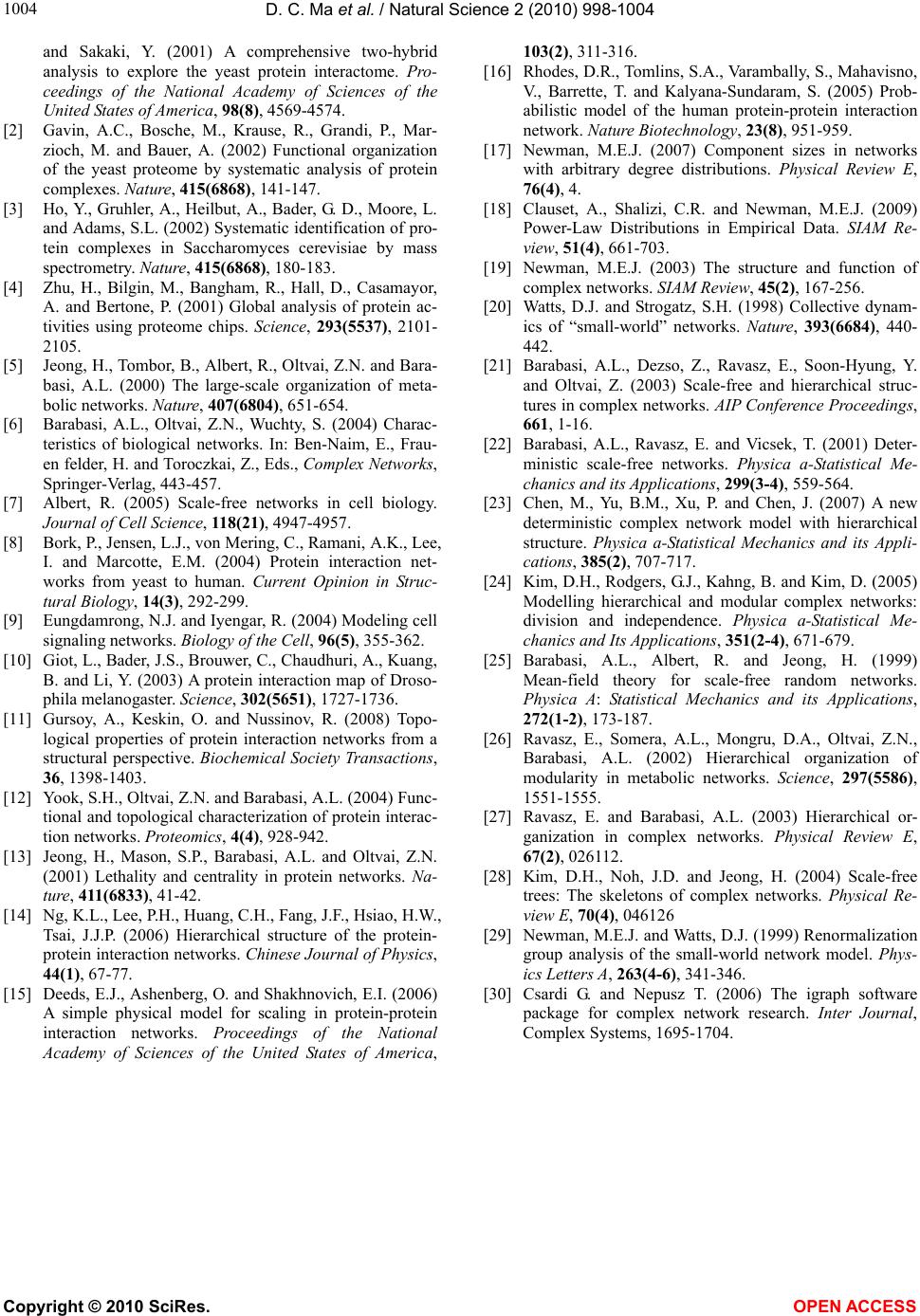
D. C. Ma et al. / Natural Science 2 (2010) 998-1004
Copyright © 2010 SciRes. OPEN ACCESS
1004
and Sakaki, Y. (2001) A comprehensive two-hybrid
analysis to explore the yeast protein interactome. Pro-
ceedings of the National Academy of Sciences of the
United States of America, 98(8), 4569-4574.
[2] Gavin, A.C., Bosche, M., Krause, R., Grandi, P., Mar-
zioch, M. and Bauer, A. (2002) Functional organization
of the yeast proteome by systematic analysis of protein
complexes. Nature, 415(6868), 141-147.
[3] Ho, Y., Gruhler, A., Heilbut, A., Bader, G. D., Moore, L.
and Adams, S.L. (2002) Systematic identification of pro-
tein complexes in Saccharomyces cerevisiae by mass
spectrometry. Nature, 415(6868), 180-183.
[4] Zhu, H., Bilgin, M., Bangham, R., Hall, D., Casamayor,
A. and Bertone, P. (2001) Global analysis of protein ac-
tivities using proteome chips. Science, 293(5537), 2101-
2105.
[5] Jeong, H., Tombor, B., Albert, R., Oltvai, Z.N. and Bara-
basi, A.L. (2000) The large-scale organization of meta-
bolic networks. Nature, 407(6804), 651-654.
[6] Barabasi, A.L., Oltvai, Z.N., Wuchty, S. (2004) Charac-
teristics of biological networks. In: Ben-Naim, E., Frau-
en felder, H. and Toroczkai, Z., Eds., Complex Networks,
Springer-Verlag, 443-457.
[7] Albert, R. (2005) Scale-free networks in cell biology.
Journal of Cell Science, 118(21), 4947-4957.
[8] Bork, P., Jensen, L.J., von Mering, C., Ramani, A.K., Lee,
I. and Marcotte, E.M. (2004) Protein interaction net-
works from yeast to human. Current Opinion in Struc-
tural Biology, 14(3), 292-299.
[9] Eungdamrong, N.J. and Iyengar, R. (2004) Modeling cell
signaling networks. Biology of the Cell, 96(5), 355-362.
[10] Giot, L., Bader, J.S., Brouwer, C., Chaudhuri, A., Kuang,
B. and Li, Y. (2003) A protein interaction map of Droso-
phila melanogaster. Science, 302(5651), 1727-1736.
[11] Gursoy, A., Keskin, O. and Nussinov, R. (2008) Topo-
logical properties of protein interaction networks from a
structural perspective. Biochemical Society Transactions,
36, 1398-1403.
[12] Yook, S.H., Oltvai, Z.N. and Barabasi, A.L. (2004) Func-
tional and topological characterization of protein interac-
tion networks. Proteomics, 4(4), 928-942.
[13] Jeong, H., Mason, S.P., Barabasi, A.L. and Oltvai, Z.N.
(2001) Lethality and centrality in protein networks. Na-
ture, 411(6833), 41-42.
[14] Ng, K.L., Lee, P.H., Huang, C.H., Fang, J.F., Hsiao, H.W.,
Tsai, J.J.P. (2006) Hierarchical structure of the protein-
protein interaction networks. Chinese Journal of Physics,
44(1), 67-77.
[15] Deeds, E.J., Ashenberg, O. and Shakhnovich, E.I. (2006)
A simple physical model for scaling in protein-protein
interaction networks. Proceedings of the National
Academy of Sciences of the United States of America,
103(2), 311-316.
[16] Rhodes, D.R., Tomlins, S.A., Varambally, S., Mahavisno,
V., Barrette, T. and Kalyana-Sundaram, S. (2005) Prob-
abilistic model of the human protein-protein interaction
network. Nature Biotechnology, 23(8 ), 951-959.
[17] Newman, M.E.J. (2007) Component sizes in networks
with arbitrary degree distributions. Physical Review E,
76(4), 4.
[18] Clauset, A., Shalizi, C.R. and Newman, M.E.J. (2009)
Power-Law Distributions in Empirical Data. SIAM Re-
view, 51(4), 661-703.
[19] Newman, M.E.J. (2003) The structure and function of
complex networks. SIAM Review, 45(2), 167-256.
[20] Watts, D.J. and Strogatz, S.H. (1998) Collective dynam-
ics of “small-world” networks. Nature, 393(6684), 440-
442.
[21] Barabasi, A.L., Dezso, Z., Ravasz, E., Soon-Hyung, Y.
and Oltvai, Z. (2003) Scale-free and hierarchical struc-
tures in complex networks. AIP Conference Proceedings,
661, 1-16.
[22] Barabasi, A.L., Ravasz, E. and Vicsek, T. (2001) Deter-
ministic scale-free networks. Physica a-Statistical Me-
chanics and its Applications, 299(3-4), 559-564.
[23] Chen, M., Yu, B.M., Xu, P. and Chen, J. (2007) A new
deterministic complex network model with hierarchical
structure. Physica a-Statistical Mechanics and its Appli-
cations, 385(2), 707-717.
[24] Kim, D.H., Rodgers, G.J., Kahng, B. and Kim, D. (2005)
Modelling hierarchical and modular complex networks:
division and independence. Physica a-Statistical Me-
chanics and Its Applications, 351(2-4), 671-679.
[25] Barabasi, A.L., Albert, R. and Jeong, H. (1999)
Mean-field theory for scale-free random networks.
Physica A: Statistical Mechanics and its Applications,
272(1-2), 173-187.
[26] Ravasz, E., Somera, A.L., Mongru, D.A., Oltvai, Z.N.,
Barabasi, A.L. (2002) Hierarchical organization of
modularity in metabolic networks. Science, 297(5586),
1551-1555.
[27] Ravasz, E. and Barabasi, A.L. (2003) Hierarchical or-
ganization in complex networks. Physical Review E,
67(2), 026112.
[28] Kim, D.H., Noh, J.D. and Jeong, H. (2004) Scale-free
trees: The skeletons of complex networks. Physical Re-
view E, 70(4), 046126
[29] Newman, M.E.J. and Watts, D.J. (1999) Renormalization
group analysis of the small-world network model. Phys-
ics Letters A, 263(4-6), 341-346.
[30] Csardi G. and Nepusz T. (2006) The igraph software
package for complex network research. Inter Journal,
Complex Systems, 1695-1704.